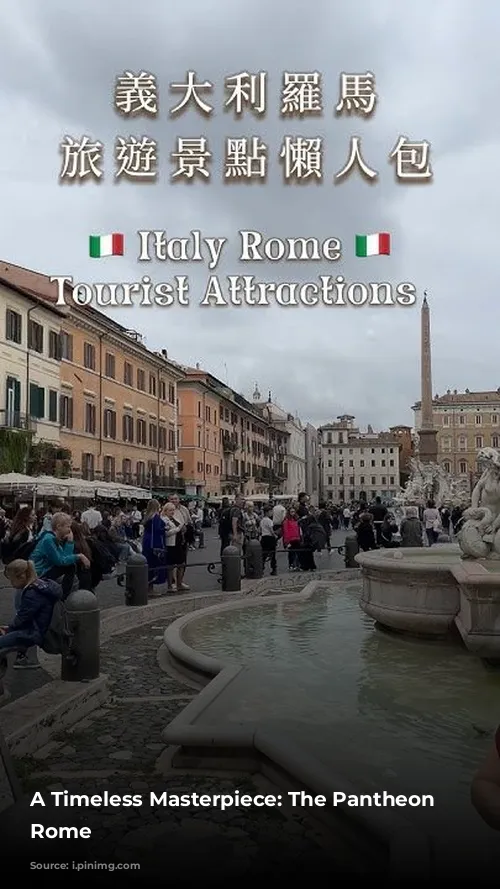The Pantheon in Rome, a magnificent temple, stands as a testament to the architectural prowess of ancient Rome. This iconic landmark has captivated hearts and minds for centuries, its grandeur and beauty defying the passage of time.
In the 19th century, the renowned French writer Stendhal eloquently described the Pantheon as “the most beautiful relic of ancient Rome,” so perfectly preserved that it seems frozen in time, as the Romans themselves might have seen it. The Pantheon’s captivating beauty has inspired generations of architects, leaving an indelible mark on the world of art and architecture.
A Legacy of Emperors and Popes
The Pantheon’s story begins in 27 BC, under the rule of Emperor Augustus. His trusted advisor and son-in-law, Marcus Vipsanius Agrippa, commissioned the construction of a temple dedicated to “all the gods.”
However, the present Pantheon is a testament to the vision of Emperor Hadrian, who embarked on a monumental reconstruction between 118 and 125 AD. He expanded the temple, reversing its original orientation and adding a magnificent portico facing a spacious square.
The Pantheon’s journey through history is a fascinating blend of eras and beliefs. After periods of neglect and plunder, the temple found new life in the 7th century when Byzantine Emperor Phocas gifted it to Pope Boniface IV. The pope consecrated the building as the Basilica of Santa Maria ad Martyres, preserving it from the destruction that befell many ancient Roman monuments.
The basilica houses a significant Byzantine icon depicting the Virgin and Child, a gift from Emperor Phocas to Pope Boniface IV. This act marked the transition of the ancient pagan temple to Christian worship, symbolizing the merging of history and faith.
A Symphony of Stone and Light
The Pantheon’s majestic form is a testament to Roman engineering and architectural brilliance. It boasts a cylindrical structure crowned by a monumental dome, preceded by a portico adorned with Corinthian columns.
The dome itself is a masterpiece of engineering, spanning over 43 meters in diameter and soaring to the same height, a harmonious balance that reflects the principles of Roman architecture. Inside, the weight of the dome rests on eight massive pylons, surrounding a spacious circular cell. This ingenious design is a testament to the Romans’ mastery of concrete and engineering, creating a space of unparalleled grandeur.
What truly sets the Pantheon apart is its innovative use of light. A circular opening, known as the oculus, graces the center of the dome, acting as the sole source of natural light. During the summer solstice, a sunbeam bathes the floor with a radiant circle, a celestial spectacle that speaks to the harmonious relationship between nature and architecture.
A Tapestry of History and Art
The Pantheon has served as a canvas for the passage of time and the expression of diverse artistic styles. In the 17th century, Pope Urban VIII Barberini ordered the removal of bronze coverings from the portico to create a canopy for St. Peter’s Basilica and cannons for the Castel Sant’Angelo. This act sparked a popular saying: “Quod non fecerunt barbari, fecerunt Barberini” – “What the barbarians didn’t do, the Barberinis did.”
In the same era, two bell towers were added, nicknamed “donkey’s ears” by the Romans, only to be removed during the unification of Italy. Finally, in 1870, the Pantheon was designated as a memorial chapel for the kings of Italy, becoming the final resting place for illustrious figures like Vittorio Emanuele II, Umberto I, Margherita of Savoy, and renowned artists such as Raphael.
Each change and addition to the Pantheon reflects its enduring presence in history, marking the passing of eras and the changing tides of power.
A Timeless Symbol of Humanity
The Pantheon is more than a structure; it is a testament to the enduring spirit of humanity. Its story weaves together emperors and popes, engineers and artists, and civilizations spanning centuries.
The Pantheon stands as a symbol of the human capacity for creativity, craftsmanship, and innovation. Its beauty transcends time, reminding us that even in the face of change and the passage of years, human ingenuity and artistic expression can endure.
From its grandeur to its subtle details, the Pantheon remains a captivating testament to the timeless power of art and architecture. It stands as a beacon of beauty, inspiration, and the enduring legacy of human achievement.
